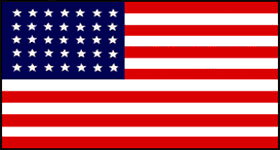 |
Civil War Battles |
|
State War Records |
| AL - AK - AZ - AR - CA - CO - CT - DE - FL - GA - HI - ID - IL - IN - IA - KS - KY - LA - MA - MD - ME - MI - MN - MS - MO - MT - NE - NV - NH - NJ - NM - NY - NC - ND - OH - OK - OR - PA - RI - SC - SD - TN - TX - UT - VT - VA - WA - WV - WI - WY |
The Battle of Fort Stedman
March 25, 1865 in Fort Stedman, Petersburg, Virginia
 |
|||||||||||||||||||||
|
By early 1865, Gen. Robert E. Lee's Petersburg defenses were perilousy weak. When Lee learned of Maj. Gen. Philip H. Sheridan's victory against Lt. Gen. Jubal A. Early in the Shenandoah valley on March 2nd, he realized that Early's forces were free to join the forces beseiging him. Before Sheridan could reach Petersburg, lee planned a final, desperate offensive, east of the city. If successful, a breakthrough might compel Lt. Gen. Ulysses S. Grant to shorten his lines, permitting at least some confederates to escape into North Carolina, joining Gen. Joseph E. Johnston.
The plan called for Maj. Gen. John B. Gordon, with 3 divisions of Lee's II Corps, elements of the I and II Corps, and a division of cavalry-almost half the beseiged army- to capture Fort Stedman, a redoubt at the far right of Grant's line, only 150 yards from a strong Confederate salient.
In a single, rapid move, Gordon was expected to overwhelm infantry from Brig. Gen. Orlando B. Wilcox's IX Corps division and a regiment of heavy artillery. Three columns of 100 men each would then seize 3 smaller forts believed to be in Fort Stedman's rear, while the rest enfiladed the Union line from the rear and attached the route to City Point, Grant's supply base.
At 4:00 A.M. in the predawn of March 25, under the command of Gordon, the first skirmishers went out and quietly overcame the unsuspecting Union pickets; 50 axmen followed, cutting down the obstructions in front of the fort. The assault overpowered the garrisons of Fort Stedman and the fort was captured quickly in the first rush. Some of the Confederates turned the captured cannon and fired on the adjacent forts while others spread out into trenches and batteries The assault overpowered the garrisons of Fort Stedman.
Those surprised Union soldiers who were not captured retreated and regrouped well enough to confine the flood of Confederates to the area around Fort Stedman. While Union batteries in the surrounding forts delivered a heavy fire. The Confederates were brought under a killing crossfire. Union infantry reinforcements arrived and added their firepower while massing for a counterattack. By 8:00 A.M., Lee, watching from Confederate lines, ordered Gordon to call off the attack. Hundreds of Confederates opted for surrender rather than face Union fire while racing the 150 yards back to the Confederate side.
Counterattacks led by Maj. Gens. Parke and Hartranft contained the breakthrough, cut off, and captured more than 1,900 of the attackers. During the day, elements of the II and VI Corps assaulted and captured the entrenched picket lines in their respective fronts, which had been weakened for the assault on Fort Stedman. The attack on Fort Stedman was a daring maneuver for the Confederates and represented their best effort. It caused little inconvenience for the Union forces, the major consequence being to delay a military review from morning to afternoon. The attack was a disaster for Lee.
This was a devastating blow for Lee's army, setting up the Confederate defeat at Five Forks on April 1 and the fall of Petersburg on April 2-3.
